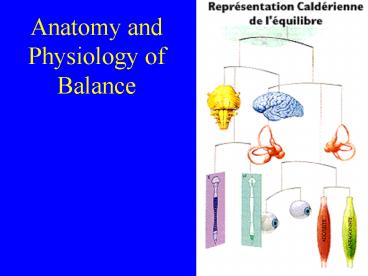Anatomy and Physiology of Balance - PowerPoint PPT Presentation
1 / 44
Title:
Anatomy and Physiology of Balance
Description:
Anatomy and Physiology of Balance ... & VI; Supports conjugate eye movement during movement of the head. Continuous with the medial vestibulospinal tract. – PowerPoint PPT presentation
Number of Views:924
Avg rating:3.0/5.0
Title: Anatomy and Physiology of Balance
1
Anatomy and Physiology of Balance
2
(No Transcript)
3
(No Transcript)
4
(No Transcript)
5
(No Transcript)
6
Vestibular Hair Cells
- Type I
- (aka inner)
- Type II
- (aka outer)
- With Kinocilium
7
(No Transcript)
8
The Semicircular Canals
- posterior canal shares plane with contralateral
anterior canal. - horizontal canals share plane.
9
Stimulated by Angular Acceleration
- greatest when fulcrum is within head
- induces relative motion of endolymph
- crista is displaced by fluid motion
10
(No Transcript)
11
Responses of the Cristae
- All kinocilia are oriented in the same direction
- Crista in each pair of canals respond inversely
to each other
12
The Otolithic Organs
- Saccule roughly
- vertical orientation,
- responds to acceleration components within
saggital plane - Utricle horizontal ( 30 deg.) orientation
13
Excitation Patterns in the Utricle
STRIOLA
Anterior
Posterior
Medial
14
Cranial Nerve VIII
15
Vestibular Portion of C.N. VIII
- superior division utricle, anterior part of
saccule, and horiz anterior canals - inferior division posterior part of saccule, and
posterior canal - to vestibular nuclei
- to cerebellum
16
Vestibulocochlear Nerve
- Exits temporal bone near its medial edge.
- Enters lateral face of brainstem at the level of
the lower pons. - Synapsing in (Cochlear and) Vestibular Nuclei
17
Responses of Vestibular Neurons
- To changes in acceleration, but onset and fade
slowly - For most normal head movements firing rates are
in phase with head VELOCITY.
18
(No Transcript)
19
Other inputs to vestibular nuclei
- Cerebellum primarily inhibitory
- Spinal cord
- Pontine reticular formation
- Contralateral vestibular nuclei
20
From the Vestibular Nuclei
- Vestibulo-Oculomotor Pathways
- Direct to oculomotor nuclei.
- Indirect via reticular formation to oculomotor
nuclei (III IV and VI) - Vestibulo-Spinal Pathways
- Lateral V-S-throughout spinal cord
- Medial V-S-cervical thoracic
- Reticulospinal tract-via brainstem reticular
formation
21
Median Longitudinal Fasciculus
- A tract linking Vest. Nuclei to nuclei of CN III,
IV, VI - Supports conjugate eye movement during movement
of the head. - Continuous with the medial vestibulospinal tract.
- The mlf runs near midline ventral to ventricle IV
and the periaqueductal gray matter of the
midbrain
22
(No Transcript)
23
(No Transcript)
24
In the brainstem
- Vestibular inputs undergo integration
- Integrated signal is combined with original
(velocity driven) signal - Processing to reset spatial map for eye
musculature
25
Integration Leaky Integration
26
(No Transcript)
27
The VOR
28
(No Transcript)
29
(No Transcript)
30
(No Transcript)
31
Central Nervous System Will Adapt to Peripheral
Damage
32
Eye Movements
- Saccadesrapid shift in gaze
- Pursuitstabilize image of moving object
- Fixationstabilize image of still object
- VORstabilize image during head motion
- OKNbackup for when VOR decays to contd head
rotation - Vergent movementschange depth of focus
33
Saccades
- Pause cells inhibit
- Burst Neurons
- which stimulate
- III VI (horizontal)
- or
- III IV (vertical)
34
(No Transcript)
35
(No Transcript)
36
(No Transcript)
37
(No Transcript)
38
Compare, Select Combine Senses
Visual System
Vestibular System
Somato- Sensation
SENSORY INPUTSVisionVestibularSomatosensory
39
SOMATOSENSORY RECEPTORS
Compare, Select Combine Senses
Somato- Sensation
JointsPositionKinesthesia
MusclesLengthTension
SkinTouchPressure
40
VISUAL RECEPTORS
Compare, Select Combine Senses
Visual System
CentralOrientation Navigation
PeripheralMotion-sensitive Body-sway
41
VESTIBULAR RECEPTORS
Compare, Select Combine Senses
Vestibular System
Semi-circular canalsOrientation Navigation
Utricle SacculeHorizontal vertical accelerati
on deceleration
42
SENSORY ORGANIZATION
Determination of Body Position
Compare, Select Combine Senses
Visual
Vestibular
Somatosensory
- Processing of inputs from the periphery
- Selection based on
- Availability Accuracy
- Value for the task at hand
43
Functional Balance Navigating in our Environment
44
A Quiz
- Vestibular Pathways Quiz































